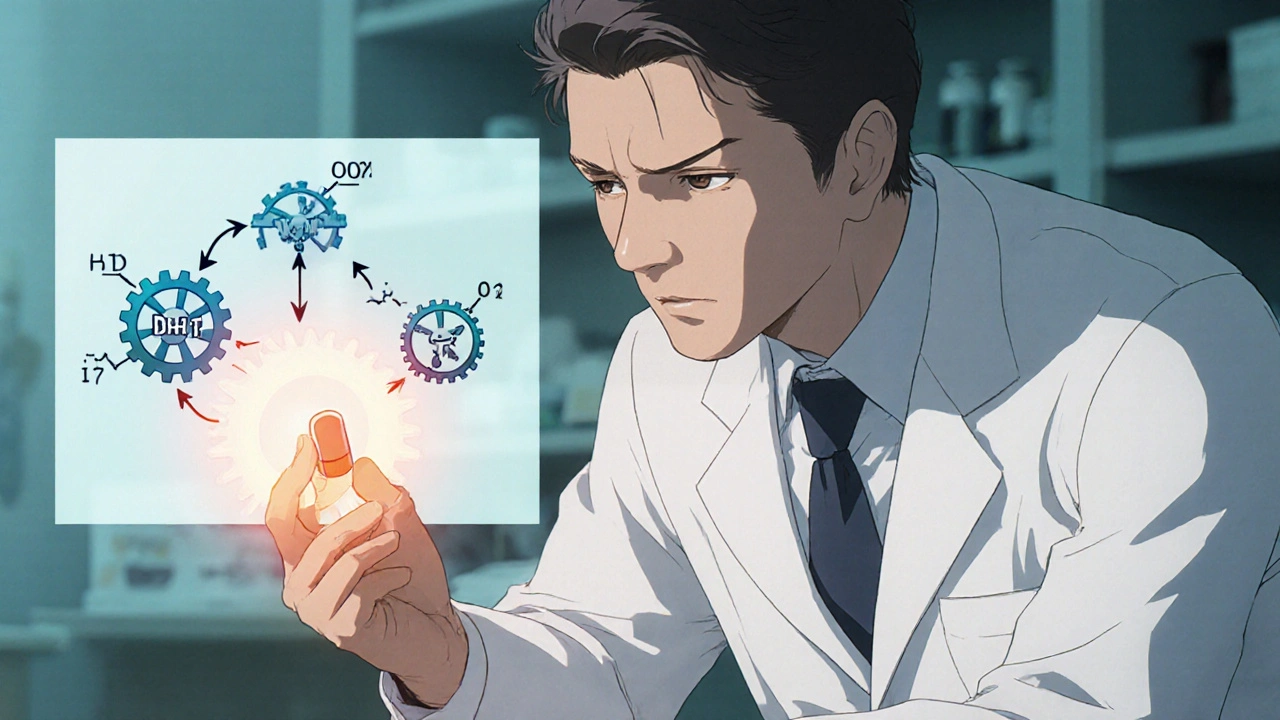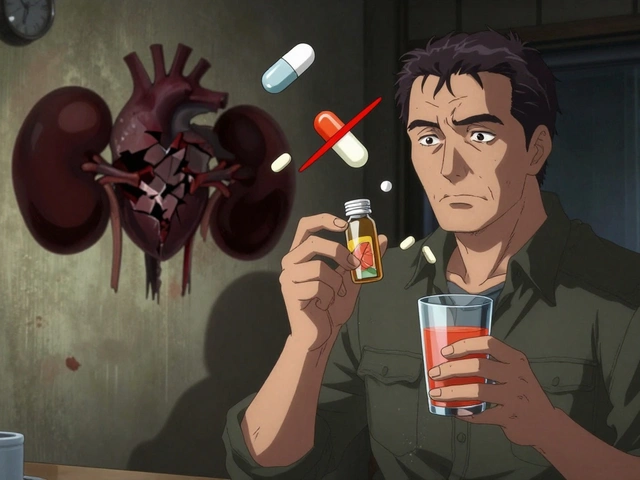
Treatment Decision Calculator
When treating an enlarged prostate or male‑pattern hair loss, Avodart (generic name dutasteride) is a prescription 5‑alpha‑reductase inhibitor that reduces dihydrotestosterone (DHT) levels. It’s often compared with other drugs that target the same hormone pathway, as well as with natural supplements that claim similar benefits. Below you’ll find a plain‑English walk‑through of how Avodart works, who might benefit, and which alternatives stack up against it on efficacy, safety, cost, and convenience.
What is Avodart (Dutasteride) and how does it work?
Avodart belongs to the 5‑alpha‑reductase inhibitor class. The enzyme 5‑alpha‑reductase converts testosterone into the more potent DHT, which drives prostate growth and shrinks hair follicles on the scalp. By blocking both type I and type II isoforms of the enzyme, dutasteride can cut serum DHT by up to 90 %.
Because DHT is a key factor in two common male health issues-benign prostatic hyperplasia (BPH) and androgenetic alopecia-Avodart is approved for BPH in many countries and is prescribed off‑label for hair loss in places where clinicians feel it offers an edge over older options.
Who should consider Avodart?
- Men with BPH: Those experiencing urinary frequency, weak stream, or incomplete bladder emptying often see symptom relief within 3-6 months of daily dosing.
- Men with progressive hair loss: If finasteride (the older 1‑mg daily pill) isn’t delivering desired density, a clinician might discuss dutasteride as a second‑line approach.
- People without contraindications: Avodart should not be used by women who are or may become pregnant, or by anyone with liver disease without close monitoring.
Top alternatives to Avodart
Below are the most common drugs and supplements that patients compare with Avodart. Each alternative hits the DHT pathway in a slightly different way.
- Finasteride (brand names Proscar 5 mg, Propecia 1 mg): Blocks only type II 5‑alpha‑reductase, lowering DHT by about 70 %.
- Proscar: The 5‑mg finasteride formulation used for BPH. Shares the same mechanism as Propecia but at a higher dose.
- Propecia: The 1‑mg finasteride pill approved for male‑pattern baldness. Usually the first prescription for hair loss.
- Saw palmetto: A botanical extract thought to weakly inhibit 5‑alpha‑reductase. Popular in over‑the‑counter supplements.
- Minoxidil: A topical vasodilator that promotes hair growth through a different pathway (blood flow) and is often combined with oral DHT blockers.
- Ketoconazole shampoo: Antifungal rinse with mild anti‑androgen activity used as an adjunct in hair‑loss regimens.
- Testosterone replacement therapy (TRT): Increases overall testosterone; may paradoxically raise DHT unless paired with a DHT blocker.

Side‑effect profile comparison
| Drug / Supplement | DHT Reduction | Common Side Effects | Serious Risks | Typical Cost (UK, per month) |
|---|---|---|---|---|
| Avodart (Dutasteride 0.5 mg) | ~90 % | Decreased libido, erectile dysfunction, ejaculation disorder, breast tenderness | Potential increase in high‑grade prostate cancer detection (controversial) | £20-£35 (generic) |
| Finasteride 5 mg (Proscar) | ~70 % | Similar sexual side effects, occasional dizziness | Same cancer‑detection concern, though less pronounced | £12-£25 |
| Finasteride 1 mg (Propecia) | ~70 % | Sexual side effects, rare depression | Low cancer‑risk impact | £9-£18 |
| Saw palmetto (extract 320 mg) | ~20-30 % | Gastro‑intestinal upset, mild headache | Very low; occasional hormone‑related changes | £5-£12 |
| Minoxidil 5 % foam (topical) | Not a DHT blocker | Scalp irritation, itching, unwanted facial hair | Systemic hypertension (rare) | £15-£30 |
Notice how Avodart offers the deepest DHT cut but carries the most robust sexual‑function side‑effect profile. Lower‑dose finasteride has a milder impact on libido, while natural extracts like saw palmetto present the fewest serious risks but also the weakest efficacy.
Clinical evidence at a glance
Two large, double‑blind trials (the REFOCUS and DIAMOND studies) showed that dutasteride reduced prostate volume by an average of 25 % over two years, outperforming finasteride by roughly 10 % in symptom‑score improvement. In hair‑loss research, a 2022 meta‑analysis of four randomized trials reported a mean increase of 15 % in hair‑count density for dutasteride versus 8 % for finasteride after 12 months.
Real‑world prescribing patterns in the UK suggest that about 30 % of urologists start BPH patients on dutasteride when the prostate is larger than 40 ml, whereas smaller glands often get finasteride first.

How to choose the right option for you
- Severity of BPH: If prostate size is >40 ml or symptoms are moderate‑to‑severe, dutasteride’s stronger DHT cut may give faster relief.
- Hair‑loss stage: Early‑stage thinning (Norwood II‑III) often responds well to finasteride; extensive loss (Norwood IV‑V) may warrant a trial of dutasteride under specialist supervision.
- Tolerance for sexual side effects: Those who have experienced libido drops with finasteride should discuss a low‑dose dutasteride trial, as some report milder effects after the first few months.
- Budget considerations: Generic dutasteride is pricier than finasteride but still affordable through NHS prescriptions. Over‑the‑counter saw palmetto is cheap but may not meet expectations for moderate‑to‑severe cases.
- Combination therapy: Pairing minoxidil with any oral DHT blocker often yields the best hair‑growth results, while adding a low‑dose alpha‑blocker (e.g., tamsulosin) can help BPH patients who have persistent urinary symptoms.
Always involve a qualified clinician when swapping or stacking these agents. Lab monitoring (PSA, liver enzymes) is recommended after the first three months of dutasteride or finasteride therapy.
Frequently Asked Questions
Can I take Avodart for hair loss?
Yes, many dermatologists prescribe dutasteride off‑label for male‑pattern baldness when finasteride isn’t enough. The dose is usually the same 0.5 mg tablet taken daily, but you need regular blood‑test monitoring.
How long does it take to see results?
For BPH, most men notice symptom improvement within 3-6 months. Hair‑loss benefits typically appear after 6-12 months of consistent use.
Is dutasteride safe for long‑term use?
Clinical trials up to 5 years show dutasteride is well‑tolerated, but men should have annual PSA checks because the drug can mask early signs of prostate cancer.
What are the main differences between Avodart and Finasteride?
Avodart blocks both type I and type II 5‑alpha‑reductase enzymes, cutting DHT by ~90 %, while finasteride blocks only type II, reducing DHT by ~70 %. This makes Avodart more potent for larger prostates and advanced hair loss, but also raises the chance of sexual side effects.
Can I combine Avodart with natural supplements?
Yes, many patients add saw palmetto or pumpkin‑seed oil for a mild extra DHT block, but these should not replace the prescription dose. Always tell your doctor about any supplement you start.
Bottom line: Avodart offers the strongest DHT reduction on the market, which translates to solid benefits for both an enlarged prostate and stubborn hair loss. Weigh that power against its side‑effect profile, cost, and your personal health goals before making a switch. A short trial under medical supervision is the safest way to decide if it’s the right fit for you.







6 Comments
The ethical calculus surrounding the indiscriminate deployment of 5‑alpha‑reductase inhibition demands rigorous scrutiny.
The when clinicians elect to suppress dihydrotestosterone en masse, they tacitly endorse a pharmacological ideology that prioritizes convenience over holistic health.
The mechanistic rationale - blockade of both isoforms I and II leading to a ~90 % DHT reduction - may appear impressive, yet it eclipses the downstream neuroendocrine sequelae.
Empirical data indicate that chronic attenuation of androgenic signaling can perturb mood regulation, libido homeostasis, and even cardiovascular resilience.
Moreover, the potential for obscuring early detection of high‑grade prostate neoplasia introduces a public‑health dilemma that cannot be dismissed as a marginal risk.
From a bioethical perspective, prescribing Avodart without exhaustive counseling violates the principle of informed autonomy.
Patients must be apprised not only of the statistical efficacy in prostate volume reduction but also of the spectrum of sexual dysfunctions, ranging from diminished erection quality to ejaculatory anomalies.
The comparative literature underscores that finasteride, though less potent, carries a comparatively attenuated adverse‑event profile, thereby presenting a more proportionate risk‑benefit ratio for many individuals.
In the realm of androgenetic alopecia, the off‑label extrapolation of dutasteride amplifies the moral hazard, as aesthetic motivations may outweigh medically justified indications.
The commodification of hair regrowth as a consumer product further muddies the waters of clinical responsibility.
Regulatory frameworks must therefore evolve to mandate longitudinal surveillance of PSA trends and hepatic function when initiating such potent anti‑androgen therapy.
In parallel, the healthcare ecosystem should incentivize shared decision‑making models that foreground patient values alongside pharmacodynamic potency.
The allure of a one‑pill solution must not eclipse the nuanced reality that endocrine modulation is a double‑edged sword.
Consequently, clinicians ought to adopt a tiered therapeutic algorithm, reserving dutasteride for cases refractory to finasteride or for prostates exceeding the threshold where type‑II inhibition alone is insufficient.
This stratified approach aligns with the principle of proportionality, ensuring that the magnitude of intervention matches the severity of pathology.
Ultimately, the discourse must shift from a simplistic potency contest to a comprehensive appraisal of long‑term quality‑of‑life outcomes.
Oh great, another glorified hair‑loss shortcut-because what the world really needed was a cheaper way to mess with your hormones, right?
The “stronger is better” mantra ignores the fact that you’re essentially hijacking a complex endocrine system for vanity.
If you love a good side‑effect cocktail, by all means, pop a dutasteride and enjoy the occasional night‑time nightmare of low libido.
Sure because swapping a tiny pill for a hormonal rollercoaster is totally risk‑free.
Listen up, folks – this isn’t some mild‑mannered vitamin you toss in with your coffee.
Avodad- I mean Avodart – is a heavyweight champ that knocks out DHT like a freight train, and if you’re not ready for the rumble, you’ll be left nursing bruised… whatever that is.
The drug’s aggressive double‑isoform blockade is as unapologetic as a street‑fighter in a suit.
You either step into the ring with a clear game plan, or you get knocked out by the side‑effects you ignored.
Wow, the drama of a tiny 0.5 mg tablet deciding the fate of my scalp and bladder is practically a soap‑opera in a bottle! I mean, every morning I stare at the pill like it’s a ticking time‑bomb, wondering whether my next bathroom break will be a victory or a tragedy.
The mere thought of losing my ‘man‑energy’ sent me spiraling into a vortex of existential dread.
And don’t even get me started on the night‑time fantasies of my hair suddenly sprouting like a 90s sitcom wig.
This isn’t just medicine; it’s a rollercoaster of hope, fear, and a whole lot of hormonal thunder.
Honestly, if you think you can just pop a dutasteride and ignore the cascade of hormonal chaos it unleashes, you’re treating your body like a cheap after‑party.
The moral imperative here is to respect the delicate balance nature set up, not bulldoze it for a quick fix.
I’ve seen too many guys brag about “no more hair” while silently crying over lost libido – that’s crossing a line no one should tolerate.
It’s not just a prescription; it’s a responsibility you owe yourself and anyone who depends on you.